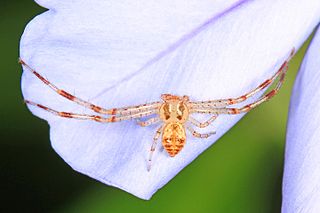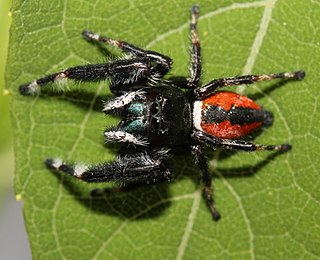
The Thomisidae are a family of spiders, including about 170 genera and over 2,100 species. The common name crab spider is often linked to species in this family, but is also applied loosely to many other families of spiders. Many members of this family are also known as flower spiders or flower crab spiders.

Misumena is a genus of crab spiders sometimes referred to as flower crab spiders. They are similar in appearance to several other genera in the family Thomisidae, such as Misumenoides and Mecaphesa.

The spider species Araneus diadematus is commonly called the European garden spider, diadem spider, orangie, cross spider and crowned orb weaver. It is sometimes called the pumpkin spider, although this name is also used for a different species, Araneus marmoreus. It is an orb-weaver spider found in Europe, where it is native, and North America, where it is introduced.

Misumenops is a common genus of crab spider with more than 50 described species.

Misumena vatia is a species of crab spider with a holarctic distribution. In North America, it is called the goldenrod crab spider or flower (crab) spider, as it is commonly found hunting in goldenrod sprays and milkweed plants. They are called crab spiders because of their unique ability to walk sideways as well as forwards and backwards. Both males and females of this species progress through several molts before reaching their adult sizes, though females must molt more to reach their larger size. Females can grow up to 10 mm (0.39 in) while males are quite small, reaching 5 mm (0.20 in) at most. Misumena vatia are usually yellow or white or a pattern of these two colors. They may also present with pale green or pink instead of yellow, again, in a pattern with white. They have the ability to change between these colors based on their surroundings through the molting process. They have a complex visual system, with eight eyes, that they rely on for prey capture and for their color-changing abilities. Sometimes, if Misumena vatia consumes colored prey, the spider itself will take on that color.

The oblong turtle, also known commonly as the narrow-breasted snake-necked turtle and the southwestern snake-necked turtle, is a species of turtle in the family Chelidae. The species is endemic to the southwestern part of Western Australia.

The northern snake-necked turtle or northern long-necked turtle is a species of turtle in the family Chelidae or Austro-South American Side-necked Turtles. It is native to northern Australia and southern New Guinea.
Yule Island is a small island in Central Province, Papua New Guinea. It is located 160 km NW from Port Moresby, on the south coast of Papua New Guinea.
The common name yellow crab may refer to any of the following species:

Misumena nigromaculata is a species of spider endemic to Madeira. It is typical to find them on top of yellow flowers such as Sonchus or Tolpis. Misumena vatia is a commonly found close relative of M. nigromaculata, and is found in a holarctic distribution.

Phidippus clarus is a species of jumping spider found in old fields throughout eastern North America. It often waits upside down near the top of a plant, which may be useful for detecting prey, and then quickly jumps down before the prey can escape. The spider is one of 60 species in the genus Phidippus, and one of about 5,000 in the Salticidae, a family that accounts for about 10% of all spider species. P. clarus is a predator, mostly consuming insects, other spiders, and other terrestrial arthropods.

Sperm precedence, also known as sperm predominance, is tendency of a female who has been bred by multiple males to give birth to their offspring in unequal proportions. Sperm precedence is an important factor in the sperm competition.
Ansiea is a genus of crab spiders that was first described by Pekka T. Lehtinen in 2004. As of June 2020 it contains two species found in Africa and Saudi Arabia: A. buettikeri and A. tuckeri.

Misumessus is a genus of North American and Caribbean crab spiders first described by Nathan Banks in 1904. They look similar to members of Misumena, but are much spinier. It was considered a monotypic genus until 2017, but its taxonomic standing has been debated throughout the 20th century, first as a synonym of Misumenops, then later as its subgenus. It was raised to genus status in 2008, but has still been confused with similar genera, some of which were only known by character descriptions made by Eugène Simon nearly fifty years earlier.
Anatrichis oblonga is a species of ground beetle in the family Carabidae. It is found in the Caribbean Sea, Central America, and North America.

Colaspidea is a genus of leaf beetles in the subfamily Eumolpinae. It is known from North America and the Mediterranean. It has recently been suggested that the Mediterranean species of Colaspidea are a sister genus to Chalcosicya, and that Colaspina forms a sister genus to the former two combined. It has also been suggested that the North American species of Colaspidea may represent a separate genus.

Mecaphesa asperata, the northern crab spider, is a species of crab spider in the family Thomisidae, found in North and Central America, and the Caribbean. It is a species of the 'flower spiders', so-called because they generally hunt in similarly coloured flowers for visitors such as bees and flies, and is a much smaller nearctic relative of the better-known Goldenrod Spider.
Leptopharsa oblonga is a species of lace bug in the family Tingidae. It is found in North America.












